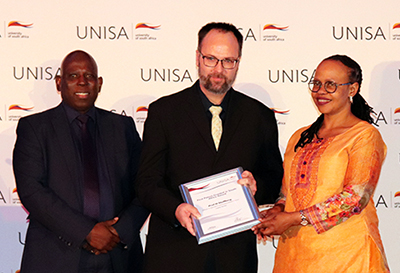
Equipped with state-of-the-art laboratories that provide students with hands-on experiences to bridge theory and practice

Ayanda Noma (Director: Innovation and Technology Transfer) and Prof Thenjiwe Meyiwa (Vice-Principal: Research, Postgraduate Studies, Innovation and Commercialisation) congratulate Prof Hennie Stoffberg (College of Agriculture and Environmental Sciences) (centre) on his First Patent Granted in South Africa Award: Irrigation Sprinkler.
Climate change is shaking up rainfall patterns in South Africa and there’s no knowing what the weather will do these days, making effective water-saving solutions increasingly sought after. One area of water wastage that’s often overlooked is the sometimes erratic spray footprint of irrigation systems used in gardens, sports fields and parks across the country.
A common problem with such systems is damage caused to their "risers" (those little upright pipes that spray the water) by passing people, animals or vehicles. When these risers are knocked skew, their coverage area can be thrown off course, spraying water where it’s not wanted, such as on pavements and paving.
A solution is in sight in the form of the "sprinkler guard" invention of Prof Hennie Stoffberg of Unisa’s School of Environmental Sciences, whose frustration with irrigation-related water wastage prompted him to act.
This device physically protects irrigation risers from life’s little knocks, thus containing their spray coverage and preventing water wastage.
Stoffberg’s sprinkler guard is already at an advanced stage of development, thanks to support from Unisa’s Directorate Technology Transfer, Innovation and Commercialisation, along with R596 000 in seed funding from the Technology Innovation Agency (TIA).
A patent for the device has been granted in South Africa, resulting in Stoffberg receiving recognition at the 2020 Unisa Research & Innovation Awards, held on 6 March 2020. He received the First Patent Granted in South Africa Award: Irrigation Sprinkler.
With this spadework already done, the intention is to prepare the sprinkler guard for commercialisation in due course.
Indications are that households and businesses alike would be receptive to this water-saving innovation, according to Stoffberg, who has done preliminary market research into potential demand for the device.
In August 2019, he and a student from Environmental Sciences set up an information stand at Decorex Joburg, where the sprinkler guard concept was introduced to the public at large through poster displays. "Over the five days, just over 200 people stopped at our stand and actively engaged us on the topic of the sprinkler guard, either wanting to buy or to give an opinion."
This device physically protects irrigation risers from life's little knocks, thus containing their spray coverage and preventing water wastage.
This response was extremely encouraging, especially considering that the device has yet to be made commercially available.
Further market research has followed, this time looking at the potential demand for sprinkler guards among wholesalers, retailers and manufacturers of irrigation systems in the province of Gauteng. "A substantial number of irrigation risers are being sold in Gauteng, which means a device of this kind would have good prospects," says Stoffberg.
In the latest step forward for his sprinkler guard, he has used 3D printing to take the device off the drawing board and into tangible form. The resulting prototype is being tested in the greenhouse at Unisa’s Science Campus in Florida.
The next step is to calculate the potential water savings from the use of the sprinkler guard. "This will help in determining viability and price," says Stoffberg, who has previous experience of inventing and patenting.
While studying landscape architecture at the University of Pretoria, he designed a baboon and monkey-proof dustbin. Later, while doing his PhD in urban forestry, he developed a method for calculating the carbon sequestration (storage) capacity of indigenous trees, for which the University of Pretoria holds the patent.
Now, with water conservation as much of a priority as carbon sequestration, plugging the holes through which water can be wasted is a matter of urgency. May the sprinkler guard rise to the occasion.
* By Clairwyn van der Merwe, Contract writer, Directorate of Research Support
Publish date: 2020-03-12 00:00:00.0